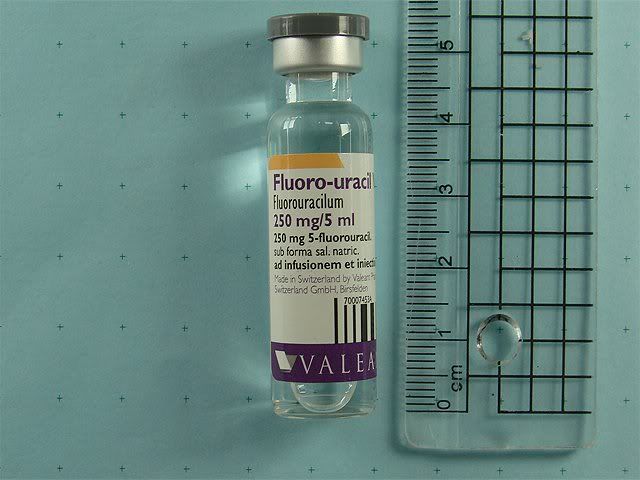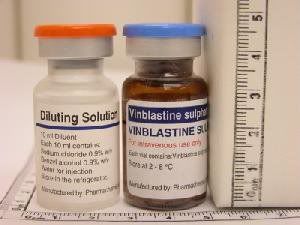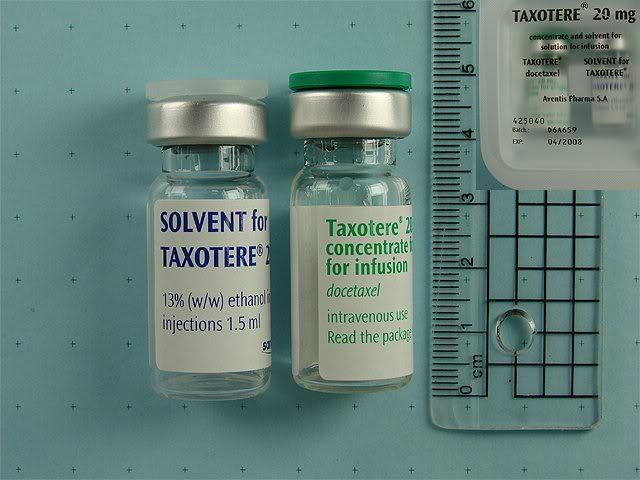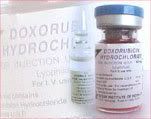CISPLATIN

1. Therapeutic uses
Cisplatin (PLATINOL-AQ, others) is given only by the intravenous route.
The dose given is:
20 mg/m2 per day for 5 days, or
20 to 30 mg once a week for 3 to 4 weeks, or
100 mg/m2, given once every 4 weeks
Interestingly, the drug also sensitizes cells to radiation therapy.
Since aluminum reacts with and inactivates cisplatin, it is important not to use needles or other infusion equipment that contain aluminum when preparing or administering the drug.
2. Side effects
Cisplatin-induced nephrotoxicity has been largely abrogated(ended) by adequate pretreatment hydration and diuresis. To prevent renal toxicity, it is important to establish a chloride diuresis by the infusion of 1 to 2 liters of normal saline prior to treatment. The appropriate amount of cisplatin then is diluted in a solution of dextrose and saline and administered intravenously over a period of 4 to 6 hours.
Amifostine (ETHYOL) is labeled for the reduction of renal toxicity associated with repeated administration of cisplatin.
Ototoxicity caused by cisplatin is unaffected by diuresis and is manifested by tinnitus and high-frequency hearing loss. The ototoxicity can be unilateral or bilateral, tends to be more frequent and severe with repeated doses, especially in children. Marked nausea and vomiting occur in almost all patients and usually can be controlled.
At higher doses or after multiple cycles of treatment, cisplatin causes a progressive peripheral motor and sensory neuropathy, which may worsen after discontinuation of the drug and may be aggravated by subsequent or simultaneous treatment with taxanes or other neurotoxic drugs.
Cisplatin causes mild-to-moderate myelosuppression, with transient leukopenia and thrombocytopenia. Anemia may become prominent after multiple cycles of treatment. Blood count test is needed to be undergone by physician along the administration of this drug.
Electrolyte disturbances, including hypomagnesemia, hypocalcemia, hypokalemia, and hypophosphatemia, are common. Hypocalcemia and hypomagnesemia secondary to renal electrolyte wasting may produce tetany if untreated. Routine measurement of Mg2+ concentrations in plasma is recommended.
Hyperuricemia, hemolytic anemia, and cardiac abnormalities are rare side effects.
Facial edema, bronchoconstriction, tachycardia, and hypotension, may occur within minutes after administration but can be treated.
5- FLUOROURACIL

1. Therapeutic uses
5-FU is administered parenterally. 5-Fluorouracil produces partial responses in 10% to 20% of patients with breast cancer.
The drugs present in Malaysia are FLURACEDYL, 5- FU TABLET KYOWA 100. While for fluorouracil, the drug is FLUOROURACIL DBL.
For average-risk patients in good nutritional status with adequate blood-cell function,500 to 600 mg/m2 with leucovorin once each week for 6 of 8 weeks
OR
Daily doses of 500 mg/m2 for 5 days, repeated in monthly cycles. When used with leucovorin, doses of daily 5-FU for 5 days must be reduced to 375 to 425 mg/m2 because of mucositis and diarrhea.
VINCA ALKALOIDS
Examples: vinblastine, vincristine, vinorelbine
A. Vinblastine
1. Therapeutic uses
Vinblastine sulfate is given intravenously to the patient. Special precautions must be taken against subcutaneous extravasation ( discharge or escape, as of blood, from a vessel into a tissue), since this may cause painful irritation and ulceration. Besides, the drug should not be injected into an extremity with impaired circulation.
The drug can be prescribed in Malaysia is VINBLASTINE SULPHATE DBL, which is administered once a week.

2. Side effects
Patient might have leukopenia which is the reducing of white blood cell and usually occurs within 7 to 10 days, but after which recovery ensues within 7 days. White blood cell count has to be monitored. Besides, patient might also get gastrointestinal disturbances including nausea, vomiting, anorexia, and diarrhea may be encountered. The syndrome of inappropriate secretion of antidiuretic hormone can be seen too. Patient has the possibility to develope ischemic cardiotoxicity. Moreover, infrequently, patient might experience loss of hair, inflammation of oral mucosa, and skin reaction. Extravasation during injection may lead to inflammation of tissues and veins. Local injection of hyaluronidase and application of moderate heat to the area may help the dispersing the drug.
3. Contraindications
If you have leucopenia, or bacterial infection, you should not be administered this drug. Besides, if you are in pregnancy, you cannot take this drug too.
B. Vincristine
1. Therapeutic uses
The usual dose given is 1.4 mg/m2 weekly for adults, maximum 2mg weekly. It is administered intravenously. The drug which can be found in Malaysia is VINCRISTINE PCH.
2. Side effects
Vincristine is mostly caused neurological side effect. However, the more severe neurological manifestations may be avoided or reversed by using suspending therapy or reducing the dosage. Besides, patient might experience severe constipation, sometimes resulting in colicky abdominal pain and again, these side effects may be prevented by a prophylactic program of laxatives and hydrophilic (bulk-forming) agents. Severe constipation usually is a problem only with doses above 2 mg/m2.
You may also get alopecia (reduction of hair ), however, it is always reversible, frequently without cessation of therapy. Although less common than with vinblastine, leukopenia may occur with vincristine, and thrombocytopenia (decrease in number of platelet in the blood), anemia (decrease of number of red blood cell under normal), polyuria (excessive secretion of urine) , dysuria (painful or difficult in urination), fever, and gastrointestinal symptoms have been reported occasionally. The syndrome of inappropriate secretion of antidiuretic hormone occasionally has been observed during vincristine therapy. As acute uric acid nephropathy will occur, to prevent hyperuricemia in the patient, allopurinol is administered to the patient.
3. Contraindications
Patient who is in pregnancy, having neuromuscular disorder, severe hepatic dysfunction, and constipation must not take this drug.
C. Vinorelbine
1. Therapeutic uses
Vinorelbine is administered in normal saline as an intravenous infusion of 30 mg/m2 given over 6 to 10 minutes, administered weekly or day 1,8 every 3 weeks. A lower dose (20 to 25 mg/m2) may be required for patients who have received prior chemotherapy. When used alone, it is initially given every week until progression of disease or dose-limiting toxicity.
The drugs which are found in Malaysia are NAVELBINE and DBL VINORELBINE.

2. Side effects
Its primary toxicity is granulocytopenia( reduction in the granular leukocyte in the blood), with only little effect of thrombocytopenia( reduction in number of platelet in blood) and less neurotoxicity than other vinca alkaloids. It may cause allergic reactions in patients and also mild, reversible changes in liver enzymes. As with the other vincas, doses should be reduced in patients with elevated bilirubin or with >75% liver replacement by metastatic disease.
3. Contraindications
Patients who are pregnant, or give lactation, have hypersensitivity to vinca alkaloids, have neutrophil count less than 1500/mm3 or severe infection, prohibited from taking the drugs.
TAXANE
A. Paclitaxel
Paclitaxel is administered into patient as a 3-hour infusion of 135 to 175 mg/m2 every 3 weeks, or as a weekly 1-hour infusion of 80 to 100 mg/m2.
The drugs presents in Malaysia includes ANZATAX, FORMOXOL, PACLITAXIN, TAXOL.

i. Anzatax
Side effects
Side effects of Anzatax might cause patients to have baldness of hair, reduction in numbers of blood cells such as neutrophil, and red blood cells. So, patients need to be monitored blood count. Besides, patient might experience peripheral neuropathy in which patient may be feeling numbness in part of body, the side effect will subside if the dose of drugs reduced. Patient might get pain in joint, difficulty in breathing, fever with neutropenia ( reduction of blood neutrophil number) ,rash, flushing and gastrointestinal tract disturbance such as nauseated, vomit, and diarrhea.
Contraindications
The drug is avoided for those with severe neutropenia. For patient, if you are pregnant or giving lactation, please avoid this drug and remember to tell your physician if you are given this drug. Those with hypersensitivity to polyethoxylated castor oil also cannot take this drug.
ii. Formoxol
1. Therapeutic uses
Dexamethasone 20mg orally 12 and 6 hour before this drug, diphenhydramine ( or its equiv) 50mg intravenously half or an hour before this drug consumed, cimetidine 300mg or ranitidine 50mg intravenously half or an hour before this drug. These drugs mentioned to reduce the side effects of Formoxol, especially hypersensitivity.
2. Side effects
Side effects of Formoxol include hypersensitivity, leukopenia or neutropenia with or without infection and thrombocytopenia. Blood cell count test needed to be monitored along the treatment. Besides, patient will exoerience loss of hair, numbness, joint and muscle pain, and gastrointestinal disturbance too. Less frequently, there will be occurrence of unusual bleeding or bruising, black tarry stools, blood in urine or stools, red spots on skin.
3. Contraindications
Patient who has hypersensitivity to polyethoxylated castor oil or baseline neutrophil count < 1500 cells/ mm3 cannot take this drug. Besides, female who is giving lactation and is pregnant, has to avoid taking this drug too.
iii. Paclitaxin
1. Therapeutic uses
It is the first line chemotherapy of breast carcinoma 175 mg/m2 intravenously over 3 hours every 3 weeks in combination with tastuzumab. While it itself as second-line chemotherapy of breast carcinoma.
2. Side effects
During utilization of this drug, patient might experience reduction in blood cells such as red blood cell, leukocytes, neutrophils, and platelet. Besides, patient might feel numbness in limbs or other part of the body, flushing, and get rash, injection site reaction, gastrointestinal tract disturbance, loss of hair, transient and mild nail and skin changes. In addition, you might also have hypotension, bradycardia (decrease in heart beat), joint and muscle pain and potential liver failure.
3. Contraindications
Patient who has severe liver impairment, concurrent, serious, uncontrolled infection, or she is either pregnant or lactation, also should not use the drug.
iv. Taxol
1. Therapeutic uses
There are single- dose therapy and combination of rug with trastuzumab.
2. Side effects
Its side effect is almost same with Paclitaxin, just patient might also experience abnormal electrocardiogram, which shows function of heart.
3. Contraindications
Patient who has hypersensitivity to polyethoxylated castor oil or baseline neutrophil count < 1500 cells/ mm3 cannot take this drug.
B. Docetaxel
1. Therapeutic uses
The drug which is sold in Malaysia, is called TAXOTERE. ). It is administered through infusion. Docetaxel has significant activity with estramustine for treatment of hormone-refractory prostate cancer. In current regimens, either drug is administered once weekly or once every 3 weeks, with comparable response rates and somewhat different patterns of toxicity.
2. Side effects
Docetaxel tends to cause more severe, but short-lived, neutropenia than does paclitaxel. It causes less severe peripheral neuropathy and asthenia ( loss of strength) , and less frequent hypersensitivity. Fluid retention is a progressive problem with multiple cycles of therapy, leading to peripheral edema, pleural and peritoneal fluid, and pulmonary edema in extreme cases. Oral dexamethasone, 8 mg/day, begun 1 day prior to drug infusion and continuing for 3 days, greatly ameliorates fluid retention. In rare cases, docetaxel may cause a progressive interstitial pneumonitis, with respiratory failure supervening if the drug is not discontinued.
3. Contraindications
Patient who has hypersensitivity to docetaxel or baseline neutrophil count < 1500 cells/ mm3 cannot take this drug. Besides, alert has to be given for those with severe liver impairment, female who pregnant or in lactation. They must not be given this drug.

ANTIBIOTICS
Doxorubicin
1. Therapeutic uses
The drugs can be gotten in Malaysia are K. U. DOXORUBICIN, DOXORUBIN, CAELYX and DOZORUBICIN DBL. Doxorubicin is available for intravenous use. The recommended dose is 50 to 75 mg/m2, administered as a single rapid intravenous infusion that is repeated after 21 days. Care should be taken to avoid extravasation, since severe local vesicant action and tissue necrosis may result.
2. Side effects
Myelosuppression is a major dose-limiting complication, with leukopenia usually reaching a nadir during the second week of therapy and recovering by the fourth week; thrombocytopenia and anemia follow a similar pattern but usually are less pronounced. Stomatitis, GI disturbances, and alopecia are common but reversible. Erythematous (redness) streaking near the site of infusion ("ADRIAMYCIN flare") is a benign local allergic reaction and should not be confused with extravasation. Facial flushing, conjunctivitis (inflammation of thin membrane lining the eyelids and covering the eyeball), and lacrimation( secretion of tears) may occur rarely.
The drug may produce severe local toxicity in irradiated tissues (e.g., the skin, heart, lung, esophagus, and gastrointestinal mucosa). Such reactions may occur even when the two therapies are not administered concomitantly.
Cardiomyopathy is the most important long-term toxicity. Two types of cardiomyopathies may occur: -
An acute form is characterized by abnormal electrocardiographic changes, and arrhythmias. This is brief and rarely a serious problem. An exaggerated manifestation of acute myocardial damage, the "pericarditis-myocarditis syndrome," may be characterized by severe disturbances in impulse conduction and frank congestive heart failure, often associated with pericardial effusion.
Chronic, cumulative dose-related toxicity (usually at or above total doses of 550 mg/m2) is manifested by congestive heart failure that is unresponsive to administered digitalis. The mortality rate in patients with congestive failure approaches 50%.Total dosage of doxorubicin as low as 250 mg/m2 can cause pathologic changes in the myocardium.
